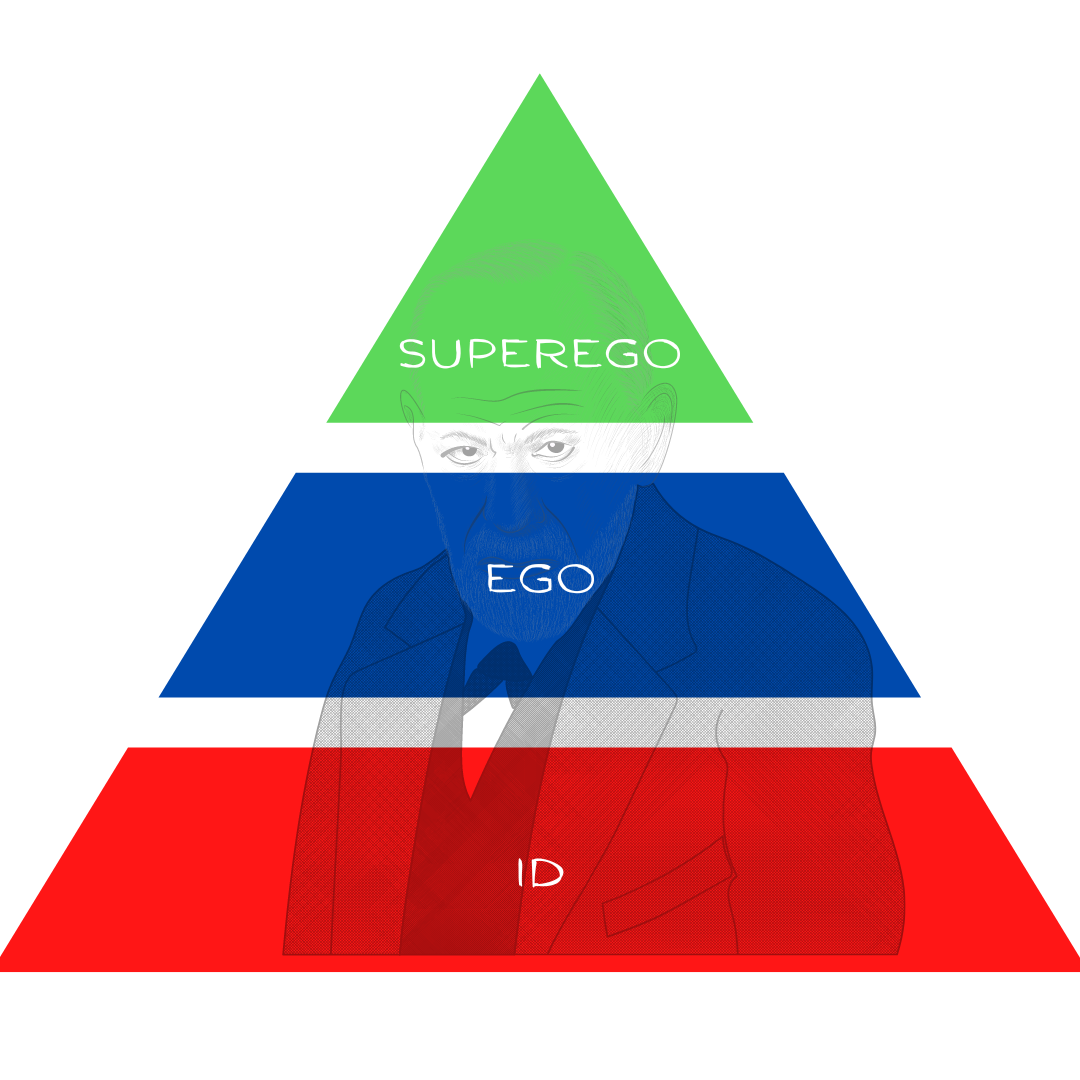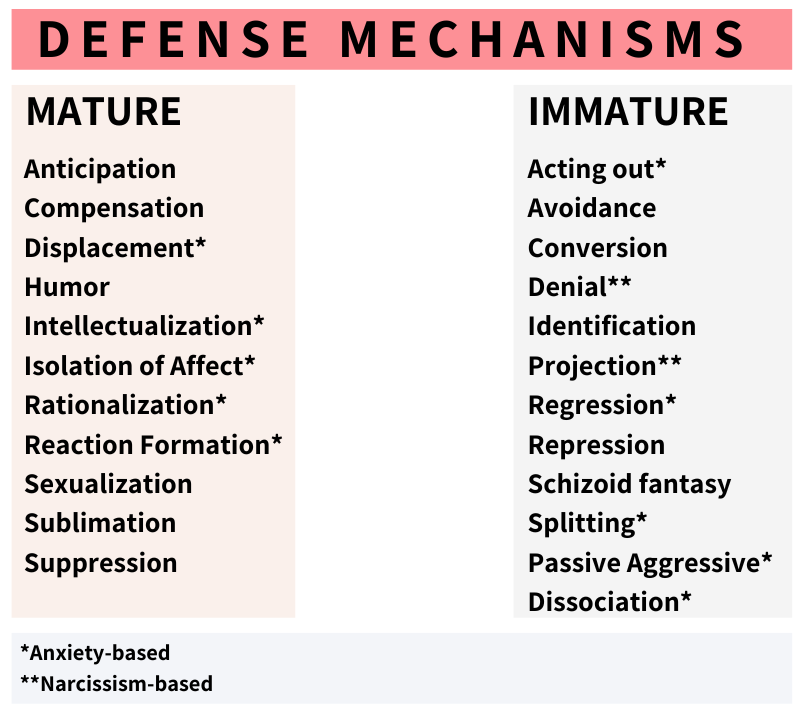Id, Ego, Superego, and Defense Mechanisms
Nineteenth century Viennese Neurologist Sigmund Freud believed the human psych consisted of three major components (id, ego, and superego) that were constantly in conflict with each other.
The id is the unconscious, primitive, and instinctive component containing all the urges and impulses, including the libido. The libido, according to Freud, is the generalized sexual energy that is used for everything from survival instincts to appreciation of art. The id is also stubborn, for it responds only to what Freud called the pleasure principle (if it feels good, do it), and nothing else.
The ego is 'that part of the id which has been modified by the direct influence of the external world.' The ego is the only conscious component. It's what the person is aware of when they think about themselves and is what they usually try to project toward others. The ego develops to mediate between the unrealistic id and the external real world. It is the decision-making component of personality.
Ideally, the ego works by reason, whereas the id is chaotic and unreasonable. The ego operates according to the reality principle, working out realistic ways of satisfying the id’s demands, often compromising or postponing satisfaction to avoid negative consequences of society. The ego considers social realities and norms, etiquette and rules in deciding how to behave.
The superego is a part of the unconscious that is the moral voice (i.e., doing what is right) and the source of self-criticism. It reflects society's moral values to some degree, and a person is sometimes aware of their own morality and ethics, but the superego contains a vast number of codes, or prohibitions, that are issued mostly unconsciously in the form of commands or "don't" statements. The superego's function is to control the id's impulses, especially those which society forbids, such as sex and aggression. It also has the function of persuading the ego to turn to moralistic goals rather than simply realistic ones and to strive for perfection.
ID: The unconscious, primitive, and instinctive component. Contains all urges and impulses, including the libido.
EGO: The only conscious component. Mediates between the unrealistic id and the external real world. The decision-making component.
SUPEREGO: Part of the unconscious. The moral voice (i.e., doing what is right) and the source of self-criticism. Controls the id's impulses.

The "Talking Cure"
Freud and his followers believed psychopathology could result from the sequestering of unwanted feelings and memories from conscious awareness. Building upon the works of his predecessors and mentors, Freud developed psychoanalysis as a “talking cure" for people suffering from "psychoneurosis.”
The goal of psychoanalysis was to “render the unconscious conscious” or bring the suppressed memories and unconscious feelings, desires, and motives into awareness where they could be integrated with the rest of mental life. To do this, Freud employed a technique termed free association whereby patients would lie on a couch facing away from the psychoanalyst and discuss whatever came to mind.
Additionally, unconscious material could be accessed through nonverbal behavior and transference/countertransference patterns as they arise in the relationship between patient and therapist. In addition, he believed dreams were driven by unconscious processes that could be analyzed and interpreted.
Defense Mechanisms
Sigmund Freud believed the conscious mind uses defense mechanisms to protect itself from disturbing and distressing feelings and fantasies. These defense mechanisms were more clearly defined and analyzed by Freud's daughter, Anna Freud, in the twentieth century.
Anna defined defense mechanisms as "unconscious resources used by the ego" to reduce internal stress. That is, people employ defense mechanisms unconsciously (i.e., outside of awareness) to resolve tension between their id and superego. She created 10 major defense mechanisms, but the number of mechanisms has since been increased by later psychoanalysts.
Psychodynamic therapy is used by clinicians to help orient patients and clients to their own unconscious processes. By recognizing and identifying these processes, patients and clients improve their self-awareness and gain a new understanding of their own behaviors. These insights can be helpful for a variety of mental health disorders, including depression, anxiety, eating disorders, and personality disorders.
Having a thorough understanding of defense mechanisms can facilitate progress in treatment. For example, recognizing the presence of defense mechanisms during a session can help maintain an appropriate therapeutic and professional relationship.
Here we define the major defense mechanisms. Depending on the context and the severity, defense mechanisms can be either maladaptive (immature) or adaptive (mature).

Immature Defense Mechanisms
Acting out: The development of detrimental behaviors that distract attention and energy away from other stressors.
Example: Temper tantrums or anger outbursts.
Avoidance: Dismissing thoughts or feelings that are uncomfortable or keeping away from people, places, or situations associated with uncomfortable thoughts or feelings.
Example: Avoiding the location of a traumatic motor vehicle accident or avoiding driving completely after a traumatic motor vehicle accident.
Conversion, Somatization: The development of physical symptoms that cannot be explained by pathophysiology or physical injury.
Example: Experiencing a headache during a very difficult and anxiety-provoking exam.
Denial: Dismissing external reality and instead focusing on internal explanations or fallacies and thereby avoiding the uncomfortable reality of a situation.
Example: Recently losing a loved one and not really believing it to be true.
Identification, introjection: The internalization or reproduction of behaviors observed in others without conscious realization of this process.
Examples: A child developing the behavior of his or her parents. A child behaving like his or her favorite fashion idol, movie star, or super-hero.
Projection: Attributing one’s own maladaptive inner impulses to someone else.
Example: When you don't really enjoy being around someone and tell people "I know that she doesn't like me. I just know it. She doesn't want to hang out with me."
Regression: Adapting one’s behavior to earlier levels of psychosocial development.
Example: The 7-year-old who starts wetting the bed again after finding out his mom is leaving on a business trip for a month.
Repression, Dissociation: Subconsciously blocking ideas or impulses that are undesirable. Separating from one's experience (i.e., out of body experience).
Example: Forgetting a traumatic experience despite being conscious during the traumatic experience. While being physically assaulted, feeling detached from the body and watching from a distance.
Splitting: Failing to reconcile both positive and negative attributes into a whole understanding of a person or situation, resulting in all-or-none thinking. Splitting is commonly associated with borderline personality disorder.
Example: Dr. Jones spends an extra 5 minutes with a patient because the clinic was running 5 minutes late so the patient says, "Dr. Jones, you are the best doctor in the entire world but the nurses and other staff here are the worst!"
Mature Defense Mechanisms
Anticipation: The devotion of one’s effort to solving problems before they arise.
Example: Preparing for an important job interview by practicing answers to the toughest questions the interviewer could ask.
Compensation: Focusing on achievement in one area of life in order to distract attention away from the inadequacy or fear of inadequacy in another area of life.
Example: A student who receives poor grades on their report card and then devotes more time and effort to extracurricular clubs and activities.
Displacement: Transferring one’s emotional burden or emotional reaction from one entity to another.
Example: A parent is angry with a coworker and comes home and starts yelling at his or her kids.
Humor: Decreasing or combating the negative emotions associated with a situation by using comedy.
Example: Someone you don't know starts screaming at you randomly on the street and you laugh it off.
Intellectualization: The development of patterns of excessive thinking or over-analyzing, which may increase the distance from one's emotions.
Example: Explaining the neurobiology of pain when feeling physical or emotional pain.
Isolation of Affect: Avoiding the experience of an emotion associated with a person, idea, or situation.
Example: Seeing the dead body of a friend but not showing any emotion.
Rationalization: The justification of one’s behavior through attempts at a rational explanation.
Example: Telling people you didn't pass the exam because it was more difficult than previous years.
Reaction formation: Replacing one’s initial impulse toward a situation or idea with the opposite impulse.
Example: Pyromaniac becomes a firefighter.
Undoing: The action of "reaction formation." Acting out the reverse of the unacceptable behavior.
Example: The pyromaniac puts out a fire.
Sublimation: Transforming one’s anxiety or emotions into pursuits considered by societal or cultural norms to be more useful.
Example: The guy who loves to get into fights with other people at bars becomes an MMA fighter to satisfy his desire for fighting.
Suppression: Consciously choosing to block ideas or impulses that are undesirable, as opposed to repression, a subconscious process.
Example: Trying to forget that your puppy died.
Other Defense Mechanisms
Sexualization: Associating sexual aspects to one’s experience of certain people, places, objects, or ideas. Sexualization can refer to the development of one’s sexual identity in general. Alternatively, sexualization can refer to the development of specific fetishes or sexual references to conventionally non-sexual entities.
Passive-Aggressive: Unconscious passive hostility.
Example: The irritable clerk at the store telling you she is busy while sitting on her phone looking at Instagram.
Schizoid fantasy: Creating an internal retreat into one’s imagination to avoid uncomfortable situations.
Why are defense mechanisms important to know?
Recognizing defense mechanisms that a client, patient, or provider may be employing can help gain better understanding of the client/patient. It can also help the family and care team facilitate a patient-centered care approach.
Psychodynamic therapy is a type of talk therapy that can involve the patient in their own care by achieving greater awareness of their own patterns of psychological defense mechanisms. Some meta-analysis studies have shown psychodynamic therapy to have equal efficacy compared to cognitive behavioral therapy and pharmacotherapy in the treatment of mild to moderate mood disorders.
References
Caligor, E, Kernberg OF, Yoeman,s FE,(2007) Handbook for Dynamic Psychotherapy for Higher Level Personality Pathology, American Psychiatric Press, 2007
Gabbard, G.O.(2004) Long-term Psychodynamic Psychotherapy: a basic text. Washington, DC, American Psychiatric Publishing, Inc. 2004
Gabbard, G.O (2005): Psychodynamic Psychiatry in Clinical Practice. 4th Edition. Washington, DC, American Psychiatric Publishing, Inc. 2005.
Luborsky L, Crits-Cristoph P (1990) UnderstandingTransference: The Core Conflictual Relationship Theme Method. New York: Basic Books.
Ferrando J., Stephen et al (2008) Psychiatry in Review. 3rd Edition. Educational Testing and Assessment Systems, Inc.
Vaillant G, Bond M, Vaillant C (1986) An empirically validated hierarchy of defense mechanisms. Archives of General Psychiatry 43: 786–94.
Bordin E (1976) The generalizability of the psychoanalytic concept of the working alliance. Psychotherapy: Theory, Research and Practice 16: 252–60.
Allen J, Fonagy P, Bateman A (2008) Mentalizing in Clinical Practice. Washington, DC: American Psychiatric Association.
Hinshelwood R, Zarate O (2006) Introducing Melanie Klein. London: Icon Books.
Stein S (1999) Bion. In S Stein (ed.) Essentials of Psychotherapy. Oxford: Butterworth-Heinemann.
Phillips A (2007) Winnicott. Harmonsworth: Penguin.
Bowlby J (2005) A Secure Base: Parent–Child Attachment and Healthy Human Development. Hove: Routledge.
Mitchell S, Black M (1995) Freud and Beyond: A History of Modern Psychoanalytic Thought. New York: Basic Books.
Stevens A (2001) Jung: A Very Short Introduction. Oxford: Oxford University Press.